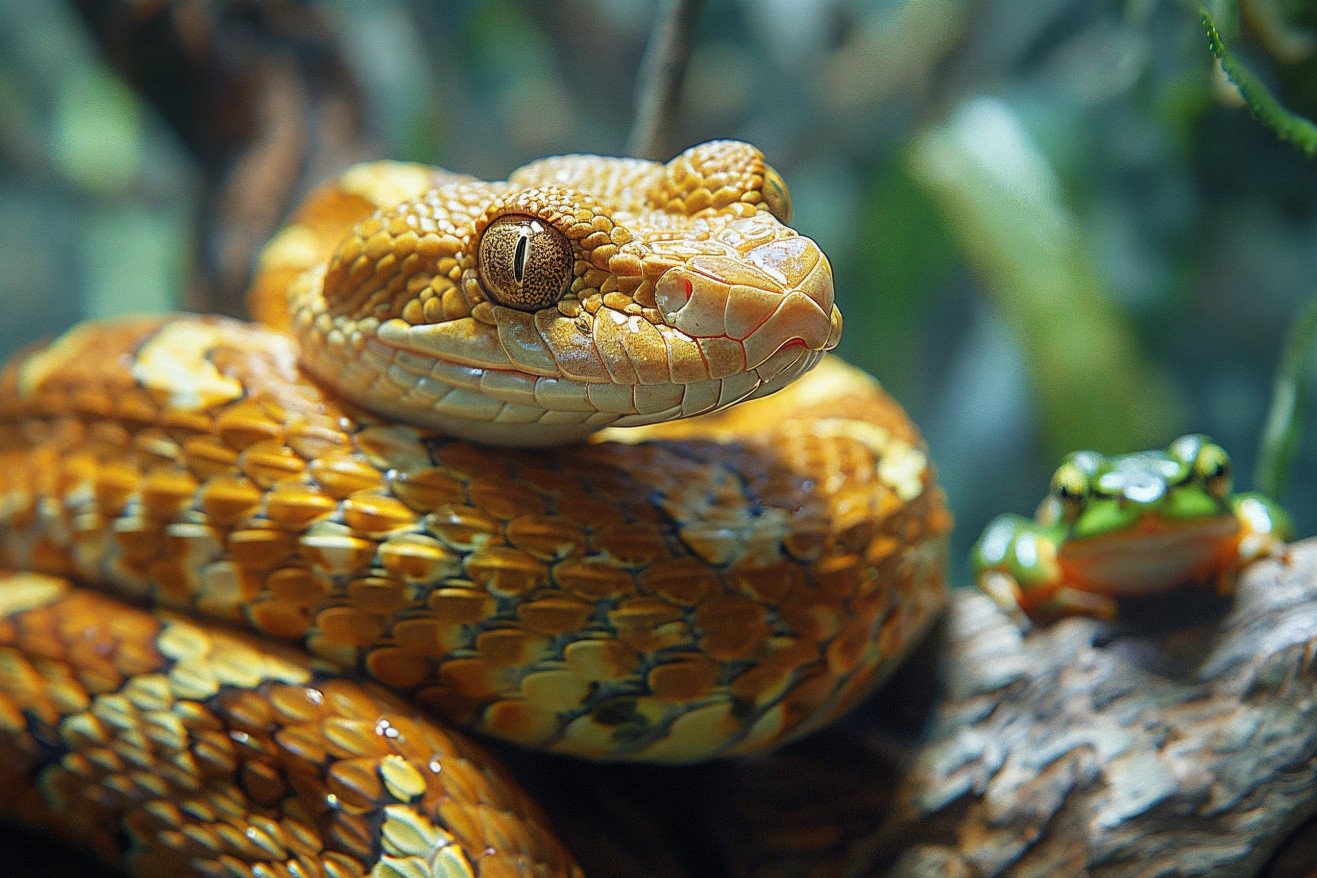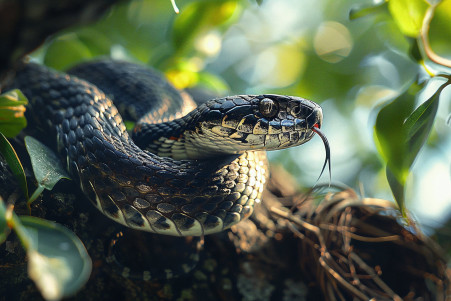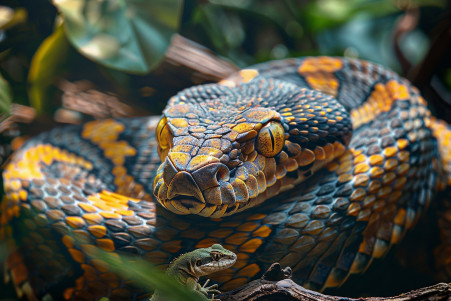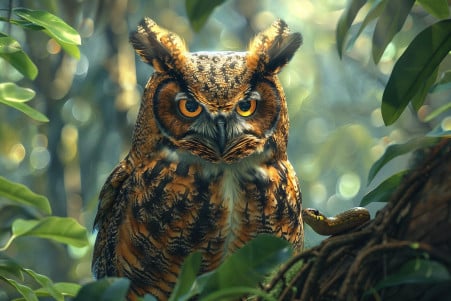Do Snakes eat Frogs? The Predator-Prey Relationship with Frogs
23 February 2024 • Updated 29 February 2024

With the wide variety of things that snakes eat, you may be wondering if amphibians are on the menu. The answer is that many species of snakes eat frogs.
The importance of frogs in the diet of snakes depends on the snake’s environment and the species of snake, and in some cases, snakes have even evolved to specialize in eating frogs. As a result, many species of wild snakes depend on frogs as a major food source.
This article will explore a number of biological and ecological studies to provide a deeper understanding of the predator-prey relationship between snakes and frogs.
This exploration will include a look at research on snake feeding patterns, an evaluation of the ecological consequences of frogs as a food source for snakes, and an investigation of the ways in which frogs defend themselves against predators. Together, these insights will provide a thorough overview of the complex predator-prey relationship between snakes and frogs in their natural environments.
Do snakes eat frogs?
Frogs: A Dietary Constant in the Snake Diet
Snakes have a wide range of diets that are as diverse as the species themselves, but many snake predators eat a lot of frogs.
According to A-Z Animals, this includes snakes like the garter snake, an opportunistic hunter, and a variety of pit vipers.
This is especially true if they live in or near an area with a lot of water, where frogs are more likely to live. The likelihood of snakes eating frogs is based on things like availability, how easy they are to catch, and how nutritious they are, which means that environmental factors, like living near a body of water, play a big role in the predation of frogs.
Wildlife Informer explains that this is especially true for snakes like the Northern water snake and the Amazon tree boa, which have a strong preference for amphibious prey. This shows how snakes can adapt to the resources in their environment.
Meanwhile, research that’s cited by Reptile Knowledge shows that snakes like the Asian pit viper and the Madagascan hognose snake have not only evolved to be resistant to the toxins in frogs but have also evolved to specialize in eating them.
In areas where there are a lot of frogs, snakes tend to eat them a lot, and this is reflected in their diets. This makes frogs a cornerstone species in their ecosystems, and it’s important for the survival of the many different snake species that live in these areas.
How Frog Decline Due to Chytrid Fungus Impacts Snake Populations and Ecosystems
The predator-prey relationship between snakes and frogs is just one example of the many ways that animals interact in ecosystems. Yet, it is a relationship that is clearly important to maintaining the balance of the ecosystems in which these animals live.
A study led by Dr. Karen Lips from the University of Maryland and published in the journal Science showed that the impact of the chytrid fungus on amphibians in Panama led to a 75% reduction in snake species diversity.
The snakes that remained were less diverse and less healthy, with many looking thin and malnourished. This study demonstrated that the health of snake populations was directly related to the availability of frogs.
The impact of the chytrid fungus on frogs has also had other far-reaching impacts on the ecosystem. A report by The Wildlife Society found that the decline in frog populations due to the chytrid fungus has led to changes in water quality, algae growth, and the populations of aquatic invertebrates. These changes show how the decline of one species can have a domino effect on the rest of the ecosystem.
While snakes are important predators of amphibians, the fact that they are so reliant on frogs as a food source also makes them especially susceptible to changes in their environment. This means that the health of snake populations is also a good indicator of the health of the ecosystems in which they live.
This is just one reason why it is important to work to conserve and protect the species and ecosystems that are impacted by the chytrid fungus.
The Art of Evasion: How Frogs Avoid Snakes
Frogs have evolved a number of ways to avoid snake predators, including chemical warfare and behavioral tactics. A study published in Frontiers in Zoology explains that poison frogs have a range of skin-secreted alkaloids that are a result of both biosynthesis and the sequestration from dietary arthropods.
These chemical defenses, including the indolealkylamine bufotenine, change in concentration over the course of an individual frog’s life, increasing as they grow and reaching their most potent levels in larger frogs, which makes them a strong defense against snakes.
On the behavioral side, A study featured on Earth.com explains that frogs use a variety of evasion strategies and that there’s a direct relationship between brain size and the strategies that frogs use to survive.
Frogs with larger brains are more likely to use escape strategies, using their intelligence to outsmart their predators. On the other hand, frogs with smaller brains are more likely to use crypsis, or camouflage, to avoid being seen by predators altogether.
These complex survival strategies are a result of the evolutionary arms race between frogs and snakes. Frogs have evolved their defenses to maximize their chances of survival, leading to the rich, complex predator-prey dynamics of their ecosystems.
Nutritional Value of Frogs in Snake Diets
The nutritional value of frogs in snake diets is high, as frogs provide a rich source of protein, fat, and essential nutrients that are important for snakes’ health and development.
An article in PMC that looked at the nutritional composition of frog waste meal found that frog meal is high in protein and contains a well-balanced amino acid profile. This is similar to fish meal and is good for the snake’s overall metabolism and muscle growth. Frogs are also high in glutamic acid, glycine, proline, arginine, and methionine, which are important for tissue repair and growth in snakes.
A study comparing Dragon snakes on the MorphMarket Reptile Community found that a frog-based diet was more beneficial than a fish-based diet. Snakes that were fed frogs exclusively had better body condition, were more alert, and were healthier overall than those that were fed fish, showing that frogs are important for providing a well-rounded diet.
For snakes in captivity, it’s important that their diet is diverse. Adding frogs to their diet can help ensure better health and more closely mimic a snake’s natural diet, which is important for making sure that their dietary needs are met. This focus on nutritional diversity is important as we move on to the next section: the complex hunting techniques snakes use to catch their nutritious prey.
The Predatory Techniques of Snakes: How Snakes Hunt Frogs
Snakes have evolved a range of predatory behaviors to deal with the speed and toxicity of frogs. As opportunistic hunters, garter snakes and pit vipers have evolved a number of ways to detect their prey.
According to A-Z Animals, snakes use a combination of their sense of smell and the ability to detect body heat to hunt frogs. While some snakes, like pit vipers, use venom to kill their prey, others, like boas, use constriction to catch frogs.
These behaviors have evolved as a result of natural selection, which has allowed snakes to adapt to their environment and the challenges it presents. For example, a study by University of Cincinnati biologist Bruce Jayne published in the Biological Journal of the Linnean Society shows that water snakes in Malaysia have adapted their hunting techniques to manipulate prey like crabs, even though they can’t chew.
In addition to natural selection, other environmental factors, like the availability of certain frog species and the presence of water, also play a role in the way snakes hunt.
In areas where there are a lot of frogs, the frequency of frog predation may lead snakes to hone their hunting skills to be more efficient and specific in the way they catch this prey. This research shows the complex and ever-changing relationship between predators and their environment, which works together to maintain the balance of an ecosystem.
What the Snake-Frog Relationship Can Teach Us: A Summary
In the complex fabric of nature, the snake’s consumption of the frog is a powerful example of the detailed and important relationships between predators and prey. These relationships not only dictate what snakes eat but also the balance of the ecosystem. As we’ve learned, the snake’s consumption of the frog can have a major impact on amphibian populations, which in turn can affect snake populations and the ecosystem at large.
It’s important to work to conserve both snakes and frogs. The factors that have led to the decline of frog populations, such as disease, have set off a chain reaction that has put natural ecosystems and the species that live in them at risk. This is a powerful example of how nature is interconnected and how delicate ecosystems can be.
Our exploration of predator–prey relationships shows us why it’s so important to protect these relationships. The snake’s consumption of the frog is a clear example of the balance of nature and the important role that predators play in that balance. In summary, let’s not forget the dance between predator and prey and let’s work together to protect their future.


